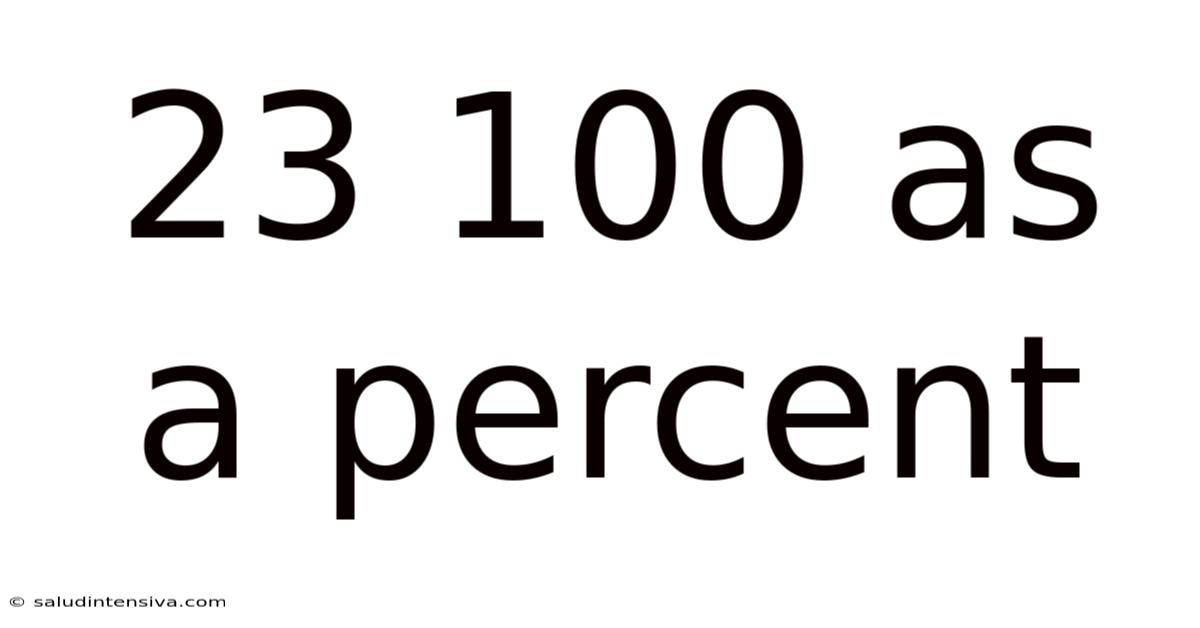23 100 As A Percent
saludintensiva
Sep 20, 2025 · 4 min read

Table of Contents
23 out of 100 as a Percent: A Comprehensive Guide to Understanding Percentages
Understanding percentages is a fundamental skill applicable across numerous fields, from everyday finances to complex scientific calculations. This article will delve into the seemingly simple question, "What is 23 out of 100 as a percent?", providing a comprehensive explanation that moves beyond a simple answer. We will explore the underlying concepts, demonstrate different calculation methods, and highlight the broader applications of percentage calculations. This guide is designed for anyone seeking a clear and thorough understanding of percentages, regardless of their mathematical background.
What is a Percentage?
Before tackling the specific problem, let's establish a clear understanding of what a percentage actually represents. A percentage is a way of expressing a number as a fraction of 100. The term "percent" itself originates from the Latin "per centum," meaning "out of a hundred." Therefore, any percentage can be easily converted into a fraction with a denominator of 100, or a decimal. For example, 50% is equivalent to 50/100 or 0.5.
This fundamental understanding forms the basis for all percentage calculations. It highlights the inherent relationship between percentages, fractions, and decimals—all different ways of expressing the same proportion.
Calculating 23 out of 100 as a Percent: The Straightforward Approach
The simplest way to determine what 23 out of 100 represents as a percentage is to directly apply the definition of a percentage. Since a percentage is a fraction of 100, and we already have the numerator (23) and the denominator (100), the conversion is straightforward:
23/100 = 23%
This method is particularly useful when the denominator is already 100. The numerator directly represents the percentage value.
Calculating Percentages: The General Formula
While the previous example was straightforward, many situations involve calculating percentages from different fractions. Here's the general formula to find a percentage:
(Part / Whole) * 100% = Percentage
Where:
- Part: The specific amount you are considering (in our case, 23).
- Whole: The total amount (in our case, 100).
Let's apply this formula to our problem:
(23 / 100) * 100% = 23%
This reinforces the simple result we obtained earlier, but the formula allows us to calculate percentages even when the denominator isn't 100.
Illustrative Examples: Extending the Concept
Let's examine a few examples to broaden our understanding of percentage calculations and their application in real-world scenarios:
Example 1: A student scored 18 out of 25 marks on a quiz. What is their percentage score?
Using the general formula: (18 / 25) * 100% = 72%
Example 2: A shop offers a 15% discount on a $50 item. What is the discount amount?
First, calculate the discount percentage: 15% of $50 = (15/100) * $50 = $7.50
Example 3: A company’s sales increased from $100,000 to $120,000. What is the percentage increase?
First, calculate the increase in sales: $120,000 - $100,000 = $20,000
Then, calculate the percentage increase: ($20,000 / $100,000) * 100% = 20%
Understanding Percentage Increase and Decrease
Calculating percentage changes (increases or decreases) is common in many applications. The formula for percentage change is:
[(New Value - Original Value) / Original Value] * 100%
A positive result indicates a percentage increase, while a negative result indicates a percentage decrease.
Converting Percentages to Fractions and Decimals
We've seen how to convert fractions to percentages. Let's also look at converting percentages to fractions and decimals:
-
Percentage to Fraction: Divide the percentage by 100 and simplify the fraction. For example, 23% = 23/100.
-
Percentage to Decimal: Divide the percentage by 100. For example, 23% = 0.23.
These conversions are crucial for various mathematical operations and applications.
Real-World Applications of Percentage Calculations
Percentages are used extensively in various fields:
- Finance: Calculating interest rates, discounts, taxes, profit margins, and investment returns.
- Science: Expressing experimental results, error margins, and statistical data.
- Business: Analyzing market share, sales growth, and operational efficiency.
- Everyday Life: Understanding tips, sales tax, and discounts.
Frequently Asked Questions (FAQ)
Q: How do I calculate a percentage of a number without a calculator?
A: You can use the fraction method. For example, to find 20% of 50, write it as (20/100) * 50. Simplify the fraction to (1/5) * 50 = 10.
Q: What if the "whole" number is zero?
A: You cannot calculate a percentage when the whole (denominator) is zero. Division by zero is undefined in mathematics.
Q: Are there different ways to express percentages besides the percentage symbol (%)?
A: Yes. You can use words (e.g., "twenty-three percent"), fractions (23/100), or decimals (0.23).
Conclusion
Understanding percentages is a valuable skill that transcends simple arithmetic. This article has comprehensively covered the calculation of 23 out of 100 as a percentage, explained the underlying concepts, illustrated practical applications, and addressed common questions. By mastering percentage calculations, you equip yourself with a powerful tool for analyzing data, solving problems, and navigating various aspects of life, from personal finance to professional endeavors. Remember the fundamental formula and its versatility—it’s the key to unlocking the power of percentages. With practice and consistent application, you'll find yourself effortlessly translating fractions and decimals into percentages, and vice-versa, becoming proficient in this essential mathematical concept.
Latest Posts
Latest Posts
-
Fibonacci Sequence In Pascals Triangle
Sep 20, 2025
-
3 4 Out Of 4 Percentage
Sep 20, 2025
-
Is 4 10 Equivalent To 2 5
Sep 20, 2025
-
12 16 Reduced To Lowest Terms
Sep 20, 2025
-
500 Square Meter In Feet
Sep 20, 2025
Related Post
Thank you for visiting our website which covers about 23 100 As A Percent . We hope the information provided has been useful to you. Feel free to contact us if you have any questions or need further assistance. See you next time and don't miss to bookmark.